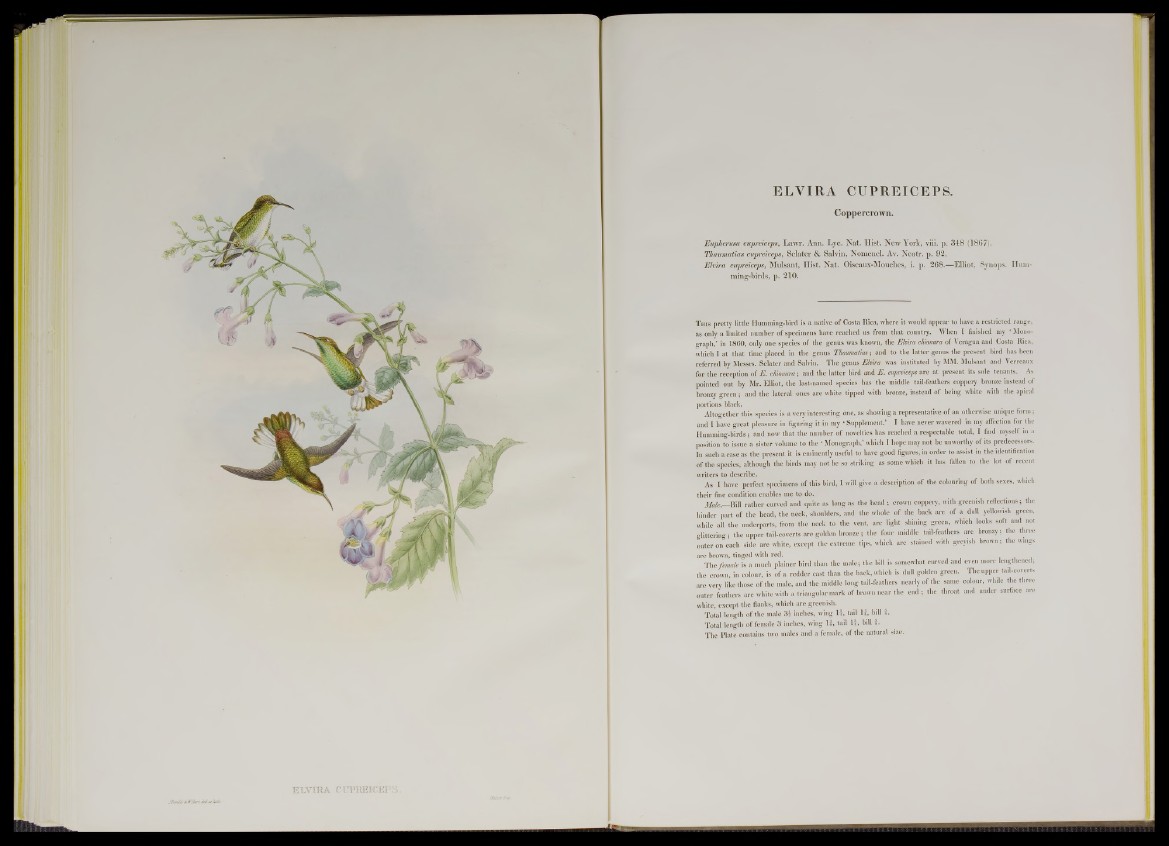
ELVIRA CUPHEICEP;
JOmiid'tJKBar&.dci'et'btfo
ELVIRA CUPREICEPS.
Coppercrown.
Euplierusa cupreiceps, Lawr. Ann. Lyc. N a t. H ist. N ew Y ork, viii. p. 3 4 8 (1867).
Thaumatias cupreiceps, Sclater & Salvin, Nom encl. Av. Neotr. p. 92.
E lv ira cupi'eiceps, Mulsant, H ist. N a t. Oiseaux-Mouches, i. p. 2 6 8 .— Ellio t, Synops. Humming
birds, p. 2 10.
T his pretty little Humming-bird is a native o f Costa Rica, where it would appear to have a restricted range,
as only a limited number o f specimens have reached us from that country. When I finished my ‘ Monograph,’
in 1860, only one species of the genus was known, the Elvira chionura of Veragua and Costa Rica,
which I at that time placed in the genus Thaumatias; and to the latter genus the present bird has been
referred by Messrs. Sclater and Salvin. The genus Elvira was instituted by MM. Mulsant and Verreaux
for the reception of E . chionura; and the latter bird and E. cupreiceps are at present its sole tenants. As
pointed out by Mr. Elliot, the last-named species has the middle tail-feathers coppery bronze instead of
bronzy green; and the lateral ones are white tipped with bronze, instead o f being white with the apical
portions black.
Altogether this species is a very interesting one, as showing a representative of an otherwise unique form;
and I have great pleasure in figuring it in my ‘ Supplement.’ I have never wavered in my affection for the
Humming-birds; and now that the number of novelties has reached a respectable total, I find myself in a
position to issue a sister volume to the ‘ Monograph,’ which I hope may not be unworthy o f its predecessors.
In such a case as the present it is eminently useful to have good figures, in order to assist in the identification
o f the species, although the birds mny not be so striking as some which it has fallen to the lot of recent
writers to describe.
As I have perfect specimens of this bird, I will give a description of the colouring of both sexes, which
their fine condition enables me to do.
Male.— Bill rather curved and quite as long ns the head ; crown coppery, with greenish reflections; the
hinder part of the head, the neck, shoulders, and the whole of the back are of a dull yellowish green,
while all the underparts, from the neck to the vent, are light shilling green, which looks soft and not
glittering; t h e upper tail-coverts are golden bronze; the four middle tail-feathers are bronzy; the three
outer on each side are white, except the extreme tips, which are stained with greyish brown; the wings
are brown, tinged with red.
Thc female is a much plainer bird than the male; the bill is somewhat curved and even more lengthened;
the crown, in colour, is o f a redder cast than the back, which is dull golden green. The upper tail-coverts
are very like those of the male, and the middle long tail-feathers nearly of the same colour, while the three
outer feathers are white with a triangular mark of brown near the end ; the throat and under surface are
white, except the flanks, which are greenish.
Total length o f the male 3£ inches, wing If, tail If, bill £.
Total length of female 3 inches, wing I f, tail I f, bill f .
The Plate contains two males and a female, of the natural size.